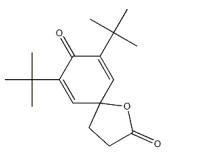ChemicalBook > Articles Catagory List >Natural-Products >what-is-7-9-ditert-butyl-1-oxaspiro-4-5-deca-6-9-diene-2-8-dione-
What is 7,9-ditert-butyl-1-oxaspiro[4.5]deca-6,9-diene-2,8-dione?
Feb 13,2020
7,9-Ditert-butyl-1-oxaspiro[4.5]deca-6,9-diene-2,8-dione (C17H24O3, CAS registry No. 82304-66-3) is an oxaspiro compound that is 1-oxaspiro[4.5]deca-6,9-diene-2,8-dione carrying two additional tert-butyl substituents at positions 7 and 9. It is an oxaspiro compound with a lactone, an enone and a cyclic ketone. Its melting point is 139-140°C.
7,9-Ditert-butyl-1-oxaspiro[4.5]deca-6,9-diene-2,8-dione belongs to flavonoid compound. It can be found in morels (Morchella spp.), which are among the most valuable and important mushrooms because of their taste and commercial value. 7,9-Ditert-butyl-1-oxaspiro[4.5]deca-6,9-diene-2,8-dione, as one of the aroma components in mushrooms, can be analyzed by headspace gas chromatography mass spectrometry (HS-GC/MS)[1]. 7,9-Ditert-butyl-1-oxaspiro[4.5]deca-6,9-diene-2,8-dione can be identified as one of bioactive compounds in whole plant extract of Euphorbia pulcherrima, which are used in folk medicine to treat skin diseases, gonorrhea, migraine, intestinal parasites, and warts[2]. It can also be found as phyto-active compound in Manilkara Hexandra (Roxb.) Dubard Stem Bark[3]. In addition, 7,9-ditert-butyl-1-oxaspiro[4.5]deca-6,9-diene-2,8-dione can also be found in marine algae, which have been highly acknowledged to possess noticeable pharmacological activities, including antineoplastic, antimicrobial and antiviral activities due to their specific functional compounds (which are not available in other plants). It can be identified with other active compounds by gas chromatography-mass spectrometry analysis of ethanol extract of Clathria baltica[4]. It also can be determined as the intermediate chemical compounds during the fermentation of spoilage date juice (SDJ) by newly isolated yeast strain Hanseniaspora guilliermondii KKUY-0045[5].
7,9-Ditert-butyl-1-oxaspiro[4.5]deca-6,9-diene-2,8-dione can be used in the manufacture of plastic materials. It can be found in pharmaceutical packaging materials. Pharmaceutical packaging employs a wide variety of polymers owing to their desirable features, but the compounds that could leach from the polymers into the drug products can pose serious health risks. 7,9-Ditert-butyl-1-oxaspiro[4.5]deca-6,9-diene-2,8-dione exactly is one of leachable impurities which leached into the ophthalmic drug solution during storage[6]. These impurities are the degradation products of a polymer additive Irganox 1010 which is widely used in the manufacturing of polypropylene bottles employed for drug product packaging. It also can be found in the plastic packaging materials, which are widely used in food packaging applications for their excellent properties[7].

Fig 1. Chemical structure formula of 7,9-ditert-butyl-1-oxaspiro[4.5]deca-6,9-diene-2,8-dione
References
[1].TaŞKin, H., Detection of Volatile Aroma Compounds of Morchella by Headspace Gas Chromatography Mass Spectrometry (HS-GC/MS). Notulae Botanicae Horti Agrobotanici Cluj-Napoca 2013, 41 (1), 122.
[2].Sharif, H. B.; Mukhtar, M. D.; Mustapha, Y.; Lawal, A. O., Preliminary Investigation of Bioactive Compounds and Bioautographic Studies of Whole Plant Extract ofEuphorbia pulcherrimaonEscherichia coli,Staphylococcus aureus,Salmonella typhi, andPseudomonas aeruginosa. Advances in Pharmaceutics 2015, 2015, 1-14.
[3].Monisha, S. I.; Vimala, J. R., Extraction, Identification and Pharmacological Evaluation of Phyto-Active Compound in Manilkara Hexandra (Roxb.) Dubard Stem Bark. Biosciences, Biotechnology Research Asia 2018, 15 (3), 687-698.
[4].Tatipamula, V. B.; Killari, K. N.; Prasad, K.; Rao, G. S. N. K.; Talluri, M. R.; Vantaku, S.; Bilakanti, D.; Srilakshmi, N., Cytotoxicity Studies of the Chemical Constituents from Marine Algae Chara baltica. Indian J Pharm Sci 2019, 81 (5), 815-823.
[5].Hashem, M., Intermediate and pharmaceutical compounds associated with fermentation of spoilage date fruits by Hanseniaspora guilliermondii KKUY-0045. Egypt. Acad. J. Biolog. Sci. 2014.
[6].Singh, G.; Gollapalli, R.; Blinder, A.; Patel, M., Identification of leachable impurities in an ophthalmic drug product originating from a polymer additive Irganox 1010 using mass spectroscopy. Journal of Pharmaceutical and Biomedical Analysis 2018, 152, 197-203.
[7].García Ibarra, V.; Rodríguez Bernaldo de Quirós, A.; Paseiro Losada, P.; Sendón, R., Non-target analysis of intentionally and non intentionally added substances from plastic packaging materials and their migration into food simulants. Food Packaging and Shelf Life 2019, 21, 100325.
You may like
What is Paeoniflorin benefits?
Dec 17, 2024
Related articles And Qustion
See also
Formic Acid
Apr 30, 2019
![82304-66-3 7,9-ditert-butyl-1-oxaspiro[4.5]deca-6,9-diene-2,8-dione;Properties;health;uses](https://www.chemicalbook.com/CAS/20180703/GIF/82304-66-3.gif)